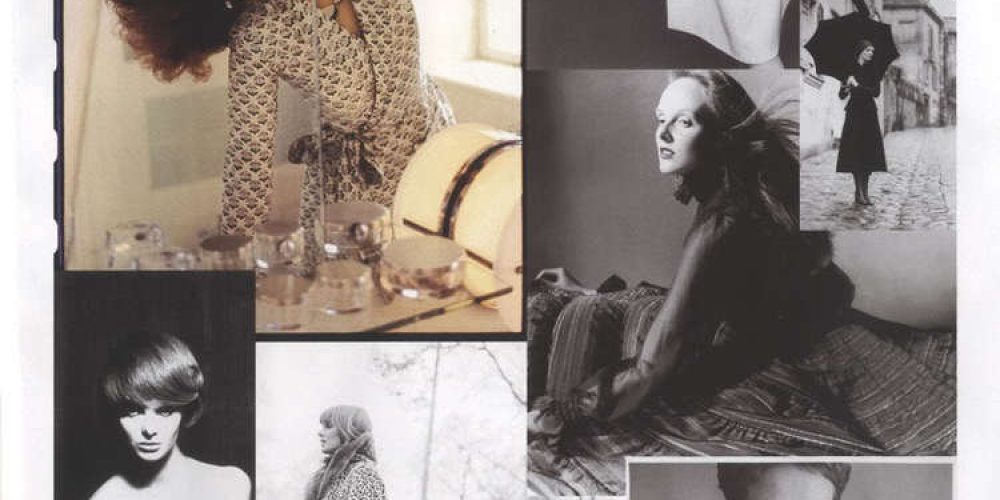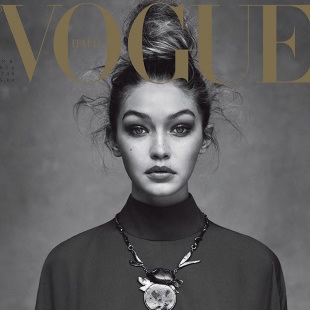Grace Coddington, Creative Director of American Vogue, published her memoir in 2012. From her many marriages, to her many cats, every chapter is fascinating. The portrait she paints of modelling in the 1950s-60s shines a light on how very different modelling is today, and how it’s very much the same.
Grace’s early career began in London (UK) where she worked as a waitress to make ends meet between jobs. She attended a modelling school, entered a modelling competition, and her first major photo shoot was entirely nude. In 2013, this reads as a step-by-step guide of “How not to become a model,” but sixty years ago, it made Grace a top model.
In the 1960s, stylists, and hair and make-up artists who specialized in photo shoots did not exist. This meant that models, including Grace, had to fill all those roles. “Each model was expected to own a model bag, and what she put in it was terribly important,” she wrote.
Today, a model bag consists of a grooming kit, smooth nude undergarments, a pair of heels, and some clothes and accessories if requested. But Grace’s bag held the following: makeup, wigs, hairpieces, hairpins, hair product, several pairs of gloves, stockings, safety pins, a sewing kit, false eyelashes, false nails, nail polish, a travel guide to London, aspirin, change for the pay phone, a book, an apple, a sandwich, stiletto pumps, a huge selection of jewellery, push-up bra, and heated hair rollers. Even after all that, Grace writes, “However well-equipped you might be, as with most situations in life, friends with influence are much more useful than face powder and rouge.”
Early on, her agency sent her to Paris to meet Eileen Ford – Co-Founder of Ford Models — as she was beginning to open agencies in various European cities. What followed was a go-see nightmare.
Ms. Ford asked Grace why she didn’t have a waist-cincher in her model bag, and told her that she didn’t think she could be a successful runway model. Wondering if perhaps Grace could be made suitable for fashion photos, Ms. Ford personally plucked Grace’s eyebrows into a tiny thin arch, which never fully grew back. After balding her brow, Ms. Ford declared that Grace was also unfit for fashion photography. Grace writes, “For goodness’ sake, I was five feet nine, with an eighteen-inch waist, thirty-three-inch bust and hips, and long legs – and Vogue loved me. How bad could I honestly be?”
At the height of her career, Grace got into a terrible car crash. Her face was smashed into the driving mirror, slicing off her left eyelid. In the operating room, she recalls mentioning to the doctor that she was a model. “He decided to take out all the stitches he had already sewn into my eyelid and start again, making them much smaller and neater. I was horrified. Even if I wasn’t a model, shouldn’t I be getting the best treatment possible?”
For the next two years, Grace didn’t work very much. Little by little she began working again, and because models did their own make up, she could blend black eye shadow into the creases of her eye sockets and hide the damage. In 2013, there would’ve been no way she could’ve camouflaged the damage for a casting.
Grace’s experiences shaped her casting decisions when she came to work at British, and later American, Vogue. She has a preference for models who, like herself, are quirky, have some individuality, and can play a character. “I don’t like it when they complain, but I’m happy to take care of them when they don’t,” writes Grace. “I try not to put them in dangerous situations – like when some stupid photographer tries to pose them on a wall with a hundred-foot drop on the side.” Thank you, Grace.
She describes the difficulty it takes to hire the models of the calibre she wants because they all have large advertising contracts that small-paying Vogue can’t compete with.
She writes that Daria Werbowy hates modelling, “But she’s so stunningly beautiful, I have to catch her when she’s in the mood to work. Unfortunately she loves sailing and doesn’t put into port too often.”
Grace met Naomi Campbell when she was only 15-years-old. Grace brought her from England to shoot with Arthur Elgort based on dance because Naomi said she had formal ballet training. Arthur thought otherwise, saying, “This girl has no more ballet training than I have been to the moon.” Grace writes, “He kept up a string of complaints about her stance and poor footwork and the way she scrunched her shoulders.” But soon after, Naomi met Steven Meisel, and has since done pretty well for herself.
Grace’s story reminds us how unpredictable the modelling industry can be; she met legendary photographer Norman Parkinson when she was working as a waitress; she happened to win a modelling contest and get her big break in Vogue. Grace’s story also reminds us how to adapt to the challenges that are thrown our way, persevere through criticism, and (thinking of that model bag) always be prepared.
Since her appearance in the documentry about Vogue, The September Issue, Grace has gained fans all over the world (see Madison Schill’s testimonial below) for her creativity, blunt honesty, and sarcasm. Grace: A Memoir is filled with outrageous stories, accompanied by gorgeous photographs and plenty of Grace’s own cartoonish illustrations.







Comments 0